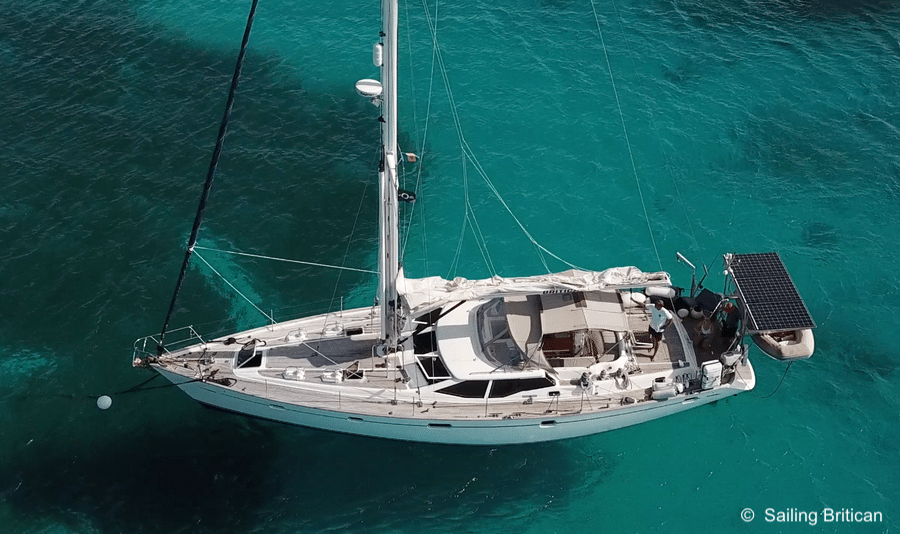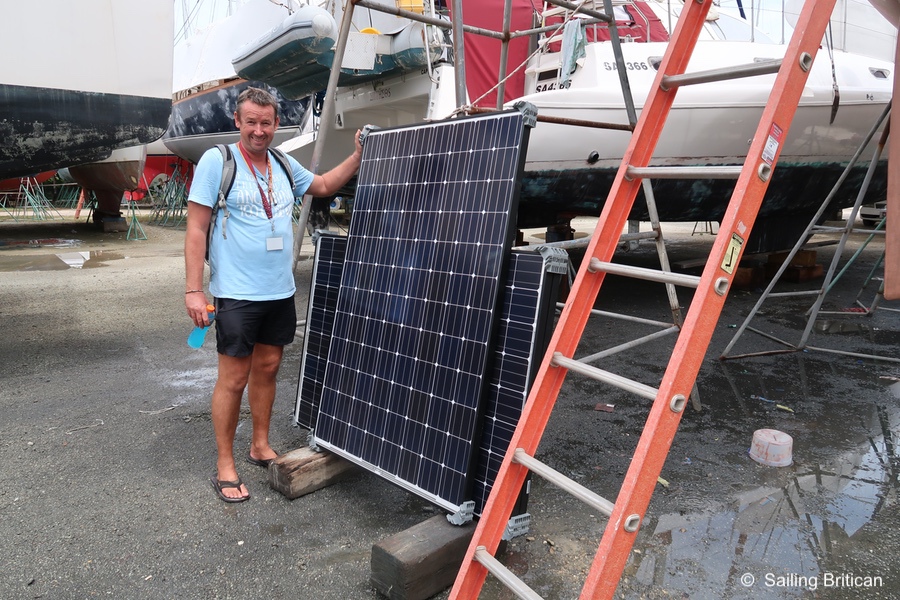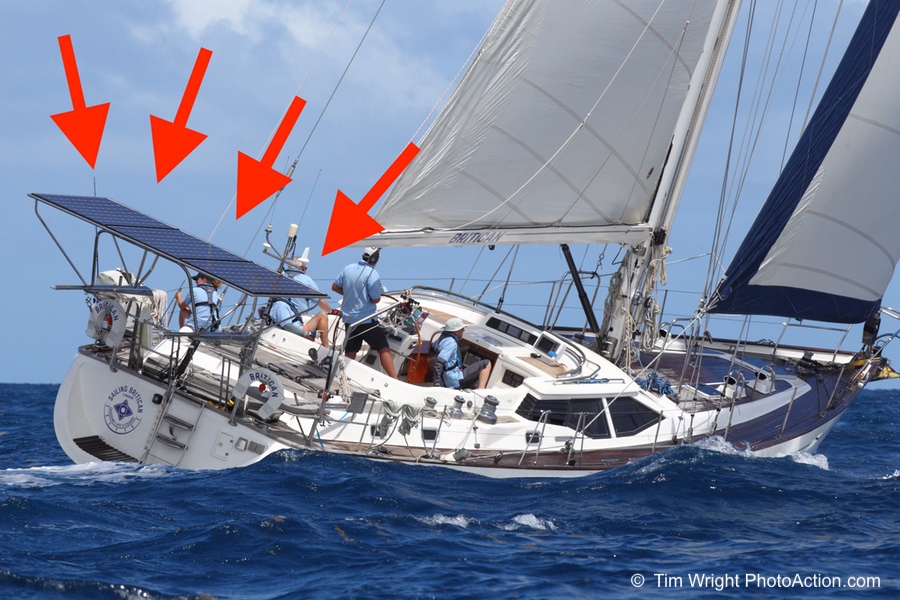Here’s the scoop on our solar power installation on a sailboat – Sailboat Britican. We are five years into our liveaboard lifestyle and we still cannot say we are experts about the power systems on our boat. But it has been enough time for us to determine that a solar power installation was in need.
When living in a house, you turn on a switch or press a button, and things work. In a closet hidden in the house, or on the outside wall, there’s a disk that rotates around indicating that electricity is being used. And every month a bill comes through. That’s it.
On a boat, it’s not so simple. It’s not so simple at all.
On Britican we have to work hard to manage our power generation and consumption. It’s a part of day-to-day liveaboard life. To ease our carbon footprint and after much deliberation, we finally got a big huge ‘proper’ solar panel system. Watch the video to discover why we did it, where we did it, how much it cost and the process involved.
And when you’re done with the video, read below on my take about how electricity/power work on a boat. Perhaps, if you haven’t yet purchased a boat, you can keep this article in mind when it comes to determining the kind of power systems that would be ideal for you and your boat.
Solar Power Installation On A Sailboat Video
But how does power work on a boat – in general?
In an effort to provide you with a layman’s description about how power works on a sailboat, let me break down some of the systems to give you a broad view. And then I can explain why we chose to install solar, how we did it and the benefits of doing so. At the center of a boat’s core power system are the batteries.
There is often one or more batteries for the engine/generator and then there is a separate battery or batteries for the running of the boat. All together they’re known as the ‘battery bank.’
The batteries for the engine(s) are simply used to start themselves, just the same way a car battery starts the car engine.
The batteries that run the domestic elements of the boat are used for the lights, navigation systems (radar, GPS, VHF, AIS, plotters, etc.), pumps (bilge, toilet, drains), fridge, freezer and in some cases sockets. These are the core elements that make the boat operational.
When powering the core elements while sailing, the batteries will slowly go down, so it’s a daily ritual to check the battery bank level often. If the levels get too low power needs to be generated to top them back up.
It’s important to know that things like water makers, air conditioning, electric ovens, washing machines and anything requiring large loads of power need the use of a generator.
| THE BRITICAN EXPERIENCE - A LIFE CHANGING WEEK-LONG LIVEABOARD EXPERIENCE | |
|---|---|
 | Do you want to have a blast? Find out what it takes to own, operate and manage a sailboat as a liveaboard cruiser. You choose the itinerary, what you want to learn, where you want to sail and how best to gain greater confidence. The ultimate outcome is to help you/your family to take several steps forward on your plans to set sail. Imagine a combination of learning how to own/operate a boat AND explore beautiful destinations? It's a great opportunity to try-before-you-buy. Find out if the liveaboard life is for you and your family now! Click here for more information. |
Batteries are getting better and will eventually run high powered items.
Many boaties are starting to seriously consider lithium batteries – these have the potential to offer many benefits but they’re extremely expensive. We’re all waiting for the cost to go down 🙂
On the most basic level, many boats are set up to have the engine(s) charge the battery banks. Our boat engine charges it’s own batteries and also the domestic batteries when running.
In addition to the engine charging the batteries, there are a variety of other ways that the batteries get topped up. They include:
- being plugged into a power source outside the boat (being in a marina)
- running the generator
- solar power
- wind power
- water power (underwater power generation)
If your aim is to be a cruiser you’ll most likely spend the majority of your time at anchor.
When at anchor you won’t be running your main engine so how do you manage your power?
In some cases, the only way the battery bank can be topped up is to run the engine. Some boats don’t have generators or other power generation sources.
Most cruising boats, however, have a generator, wind and/or solar power. When buying a boat it’s very important to understand how you’re going to get your power, how much it costs and what you need to do to keep that power source maintained.
Before selling up and setting sail I had this idealist vision that we’d be catching our own dinner, making our own water, using renewable resources and incurring a very little cost.
Well, in our case, the vision hasn’t been realized (yet) but it could be true if you get your systems set up correctly from the get-go.
Our boat has an amazingly low in power consumption for core items. We probably use around 9 amps an hour when the lights (all LED), pumps, fridge, etc. are on. Our boat, however, is massively high in power consumption for our oven, the toaster, washing machine, watermaker and so forth.
We MUST run our generator to cook. We MUST run it to make water. The same goes for the washing machine and air conditioning.
Running the generator costs money – there are the fuel costs and all the items that are regularly needed every few months for a service (impeller, oil, air filter, anode, etc.). It’s loud. And the exhaust is smelly if sitting outside downwind of the fumes.
And…it breaks down from time to time requiring a mechanic.
Our generator needs to be serviced every 200 hours. If we wanted to run the air-conditioning all the time that equates to a service every 8 days. Needless to say, we never use the air-con.
For us, there’s no way to get away from using the generator but there are ways to reduce the amount of time that we need to use it.
Before installing our solar panels we used the generator around 3 – 4 hours per day. In the morning for breakfast and then during lunch and dinner for a bit. While running the generator we’d accomplish several tasks including:
- Top up the batteries
- Cook/bake
- Do some laundry and/or make water
- Occasionally run the air con
In many occasions, we’d have to run the generator so to top up the batteries.
When we did I’d often come up with something to cook but it wasn’t my intention. I actually cooked only because the genset was on! I have an attitude that we should use the genset to it’s fullest as much as possible so we get the biggest bang for our buck…
We decided to find a way to reduce the amount of time we needed to use our generator.

We had 325 Panasonic Solar Panels, a 316 Stainless Steel frame made to weld over our davits and a Midnight Solar Classic Charge Controller installed over the course of a few days (watch the video to see the installation).
In Charleston, South Carolina we were quoted just over $10,000 for the job. In Grenada in the southern Caribbean we were quoted $12,000 and in Trinidad (way down above Venesuala), where we got it done the total was $6,500. That includes everything – the panels, rack, controller and labor.
The work in Trinidad was started while we were on the hard – the frame was put on and welded in addition to having the panels put in place. The electrics were finished up while we were back in the water.
The results of our solar power installation on a sailboat?
Now that we’ve installed our solar panels we can go days without using the generator.

As long as the sun is out (and when isn’t it in the Caribbean?), we’re at 100% in battery power by around 2 pm. We can cook using our solar cooker or BBQ gas grill which is great. And when we do there’s no need to turn the generator on at all.
The amount of time between servicing our generator has been massively extended and our constant need to watch our battery charge level has reduced. Furthermore, we now have more redundancy in our overall system. If the generator goes down it’s not the end of the world. When we put our boat on the hard we no longer need to worry if there’s a power outage (causing the batteries to drain down).
Could I live without our high-power consumption items?
We could have found a boat with systems that were not high energy. We could have found alternatives or created systems that don’t require a generator…but after reflection I don’t think it’s a bad idea to have a generator and high powered system.
What’s our issue was is that we depended 100% on our generator to top up our batteries. Now – the sun tops the batteries up for us. The generator is merely there to help us with the cooking, washing and water making.
In my dream world, what would be perfect?
To use wind, solar and water power to power the battery bank. And then to have amazing batteries that allowed us to run our high power systems. That would be my perfect scenario.
And while I’m asking…we’d also love to have a contraption we can unleash that scoops up all the plastic in the water. AND a fishing lure that works great for catching the fish we’d prefer for dinner. Hahahahaha.
Needless to say these things are important to think about when buying or refitting a boat. If you’d like to discuss our solar panel installation or how our power systems work, please send Simon and email. He’d be happy to answer any questions for you or…
Any comments or questions?
Please leave them below. If you have something you can add to make this article and video more powerful, please share!

solar power installation on a sailboat
A very good idea that most sailing vessels should embrace. In a separate video I saw that extensive solar panels used in a boat could even propel a boat, albeit smaller one, for some time – that much was the energy generated.
What you should still add, or reinstall if it’s the case, is a wind turbine generator. The two systems do not overlap in the way they work, one complements the other, and also wind generators should give some serious energy in above-mild winds.
Thank you for the comments Serban. Yes – we want to get a wind turbine at some point. That’s on the list! If only money grew on trees. Hahahaha. Smiles, Kim
There is a good deal on these lithium batteries. 4 of them would make a 12 volt battery. 8 together would be a 24 volt. https://www.ebay.com/itm/K2-Energy-K2B3V90EG-LiFePO4-3-2V-90Ah-Lithium-Iron-Phosphate-Battery/183699311681?hash=item2ac5550c41:g:zwIAAOSwaEZccFCa You can buy buss bars or make them out of copper pipe using a hammer and a drill. $450 for 90ah at 12 volt is decent. You would need a Battery management system to balance the batteries for about 20ish dollars. Ebay also has batteries with a built in BMS for 500-1000. Battleborn is also a good name. Will Prowse on youtube has a lot of battery build and solar with lithium videos. Don’t allow your charge controller to allow your batteries with lithium to drop below 20% or go higher than 80 or 90% and you will get 4 to 10 times more cycles out of your batteries. You can get a lot more energy out of a 100ah litium than you can a 100ah lead-acid. One lithium is worth like four lead acid batteries. As you know you really can’t pull more than 20% out of a lead-acid and have it last more than half a year or a year.
Wow! Thanks for all this information Allyn. We’ll check this out and start planning 🙂 Kim
The lower charge limit is fair, however there’s no limit up. You can charge them 100% and they will be OK. The “not-too-much,-not-too-little” is valid when the batteries are in storage. Their shelf life increases if they are stored half-loaded. Also, while they should not be drained if possible, one should recharge when they are fairly low. The most significant parameter for a battery (lithium-ion or otherwise) is the number of recharge cycles. You can only charge them that many times, because the chemical reactions within them are not perfect, and every time you charge a very tiny portion of the chemicals in it get combined and never switch back. Going fairly low and then recharging to full capacity maximizes the number of recharges, and this is what you want – the life of the battery gets extended. Cheers!
Britican looks just great with that solar set-up, glad it’s working for you.
Fingers crossed that Elon Musk (or someone else) radically reduces the cost of new batteries.
Keep doing what you do, you help some of us get through our mundane lives by dreaming about having the life you live.
Thank you
Thank you Doug – I agree that Britican looks good with solar 🙂 And yes, we’re waiting for the price to come down but as another person posted, there are deals out there. Big smiles, Kim
Hi guys
I saw Kim outside IGA the other day, I was going say hi but she was chatting to someone else and I didn’t want to interrupt.
I’m currently in Grenada marine waiting for a few jobs to get completed.
Your solar panel video was very informative, thank you. I have sourced 2 x Panasonic Photovoltaic Module HIT 325W VBHN325SJ47 Solar panels, are these the same as what you have had installed? Are you still happy with them?
All the best
John
Hey John! Next time you see me, please come up and say ‘hi’. We’re over in La Phare Bleu marina until Friday if you want to stop by. I’m actually working on the lightship right now and Simon’s down on the boat sanding. I need to ask him what our Solar Panel model is…I can most definitely tell you that we LOVE them. Between our solar and our Lithium batteries we barely use our genset any more. Smiles, Kim
Just a thought:……if money is a problem;…one way that might be helped is through Day Trading. Yep;….everybody runs a mile when this subject is broached…….but using a system called ‘Spread Betting’…(London Capital Group;…..LCG.com) …….you might find what you need. Don’t ditch this idea out of hand – because of the name ‘Spread Betting…….checking it out will cost you nothing;…..and it’s practically nothing (cost) to get into. Nope; I don’t work for, – or am I an Agent for LCG….in fact I have no skin in this game at all….except I am a ‘Spread Better’……….and I KNOW this could help.
Best regards.
Thank you for the tip Jeff! We’ll look into it 🙂 Kim
I enjoyed reading your blog content. It reveals everything in detail more about SOLAR POWER INSTALLATION. The post is very impressive and effective. Solar can be the perfect option instead of using batteries. Thank you and good luck in the upcoming blogs.
Do you find that having the panels on an array above Davits:
– reduces headroom as you access bathing platform?
– gets in the way when you are raising and lowering yr dinghy?
– restricts the view aft when you are at sea, berthing or whilst at anchor enjoying a sundowner?
Looks like the array is quite high above the Davit arms, do you recall how high?
Looks like a good solution. We may go for installation on Bimini as we’re not looking for quite as much power, e.g. we cook with gas
All the best
Derek
Hey Derek, To answer your questions the solar panels do not reduce headroom, nor do they get in the way. I don’t feel that they restrict our view…but when I take photos I often don’t include the panels. The panels shade the dinghy, protecting it from the sun. They also shade the sugar scoop at certain times of the day making it nice to sit there. Overall, we’re so happy with the power supply that I wouldn’t change them for anything. Smiles, Kim
Nice article, thanks.
A nit: please pay attention to units … ” 9 amps an hour” makes no sense. I think you mean 9 amps, which is already a rate. And 9 ampere-hours per hour is 9 amps.
Going forward, sailboats should be equipped from the beginning with integrated solar panel platform/dinghy stowage. It would be more economical as a feature of initial design rather than makeshift add-on. I really want this kind of retrofit but the quotes I’m getting in Annapolis make it unaffordable.
Thank you for your thoughts Kurt 😉